Signal Tower Gets a Fresh Look
|
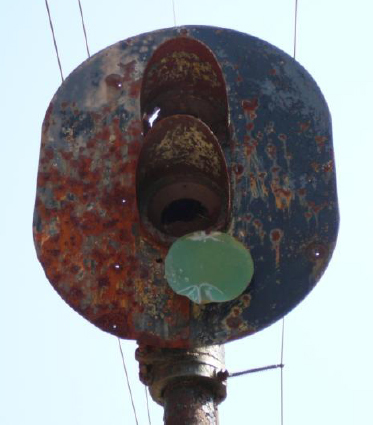
Railroad Signal Before Restoration
March 18, 2009
|
For 20 years, hikers and bikers using the Montour Trail in Coraopolis have been passing by an old rusting railroad signal and yard limit sign located a half-mile from the starting point of the Trail.
Now these railroad relics have a fresh coat of paint and a new chance to teach some history to those passing by on the Trail. The Montour Railroad Historical Society has completed refurbishing these two pieces of past Montour Railroad operation.
MRHS president Bryan Seip notes "The Montour Trail is celebrating its 20th anniversary this year and many people have been using the Trail for its recreational aspects. The Montour Railroad built and used this route for over 100 years before it became a Trail. Other than bridges, there are very few physical pieces of the Montour Railroad remaining. We thought restoring the signal and sign would be a good way to help teach the history of the railroad that served the coal mines and communities of our area."
|

|
Railroad Signal Restoration
|
The project started with scraping and cleaning of the tower mast and base. It was decided that the best way to work on the signal head would be to remove it from the mast and take it back to home shops where members could work on the individual pieces.
|
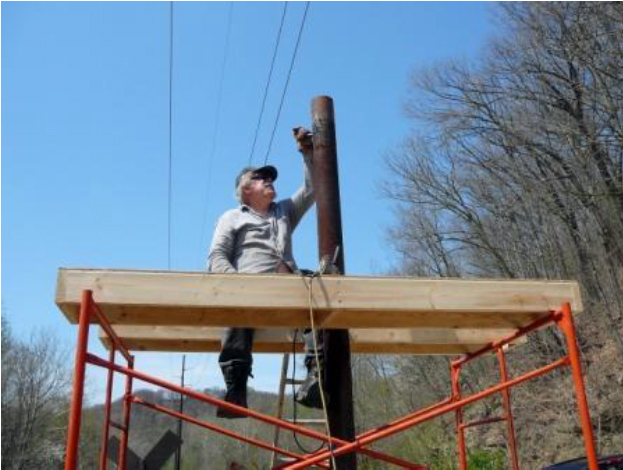
Carter Roth chips away at the mast
|
The base needed a lot of work. The side panels were rusted completely away at the bottoms and of the four bolts that held the mast in place, only one had a nut installed with purchase on the mast base plate.
|
There are also several unsavory characters residing in the signal base and head. Wasps had built their homes and the base is host to several snakes, one of which made an appearance to check out the work being performed. Trail users told us that several snakes have been seen at one time, sunning themselves on the locking handle of the rear panel. Caution was the watchword, as none of those present are snake experts. This section of track was known by several of our former Montour employees as "Copperhead Hollow" and after checking identification on the internet, I think they had it called corrrectly.
|
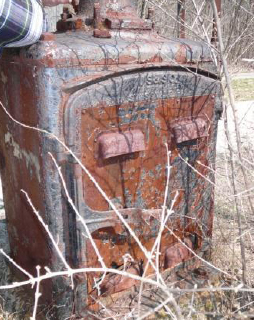
Rusted Signal Base
|
Chippers, grinders and needle scalers were put to use on the signal tower, as the work crew toiled away on a hot day.
|
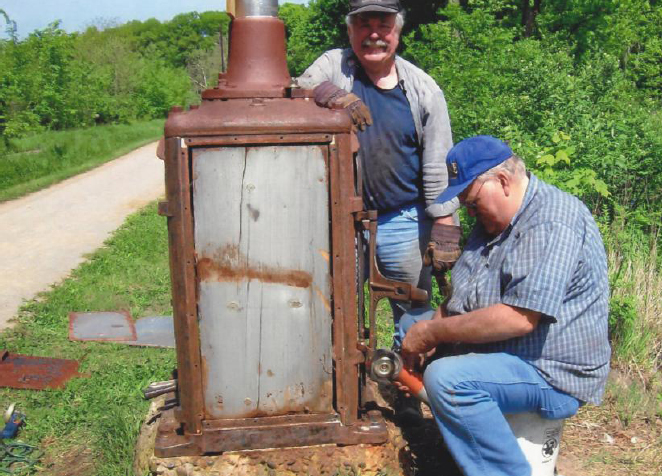
Carter Roth and R.J. Lane clean and apply primer to the base.
|
Meanwhile, a few feet away, work on the yard limit sign was also underway.
|
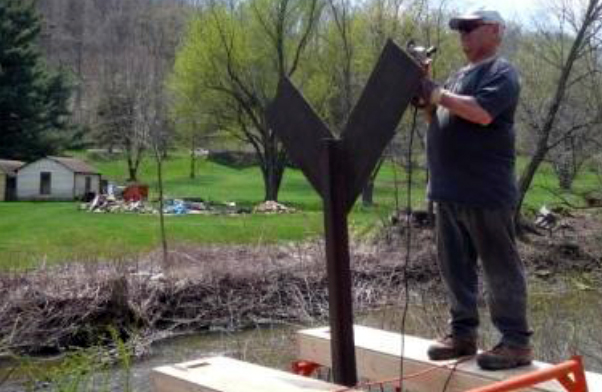
Bryan Seip hits the rusty yard limit sign with the grinder
|
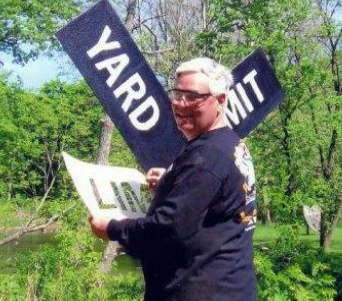
After cleaning and a base coat of paint, the stencil was applied and the yard limit sign was finished
|
The signal head pieces were taken to the crew's home shops where they were cleaned and repainted. Welding broken pieces and fabricating new sides for the base was also completed.
Then came the day for reassembly. With some help from the Airport Friends of the Trail and a lift from Harry Snyder's fork truck, the signal head was raised back to the top of the mast and bolted back into place.
|
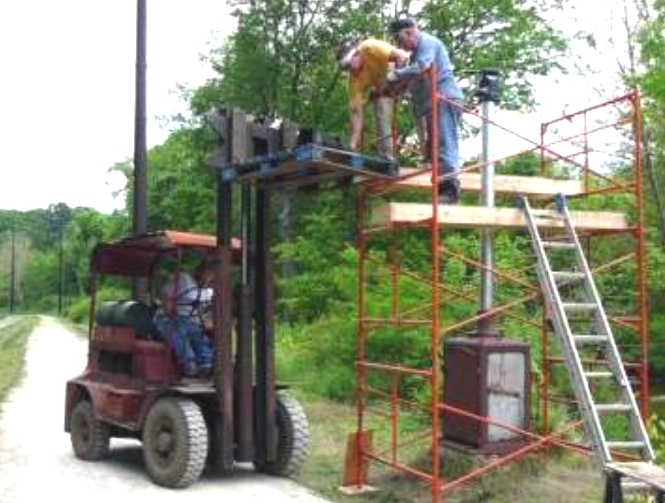
MTC member Tim Killmeyer and Carter Roth get some help from H. Snyder Steel's lift truck while reinstalling the repainted signal head at Montour mile 1.5.
|
After everything was painted and reinstalled, an informative sign was mounted on the Trail side panel and the final touch was applied as Montour RR logo decals were applied to each end of the base.
|
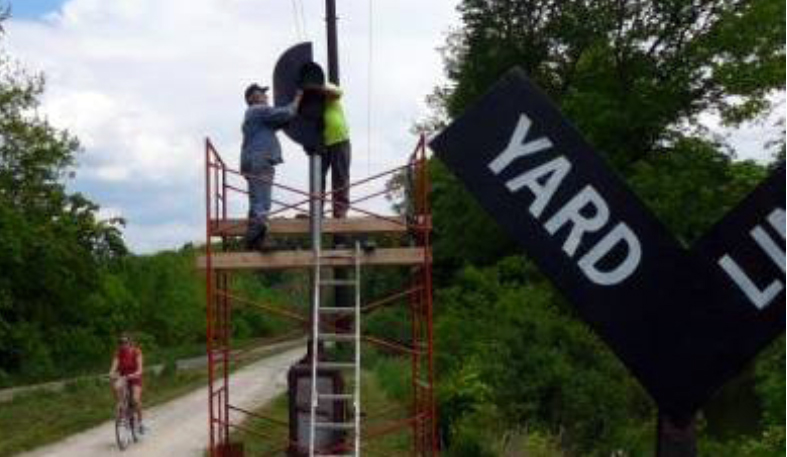
Carter Roth and Bryan Seip bolt the head pieces back together
|
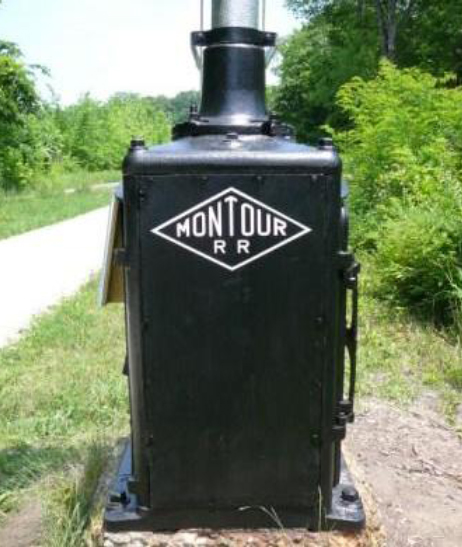
Restored base with Montour Railroad logo
|

|
The Restored Railroad Signal
|
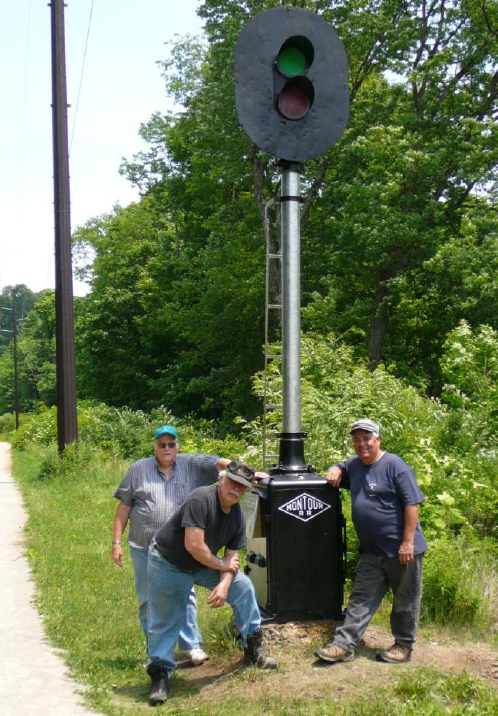
R.J. Lane, Carter Roth and Bryan Seip with the completed signal tower
June 7, 2009
|
A special THANK YOU to H. Snyder Steel and Bill Errera Truck Fabricating for their assistance and for supplying fabrication work of replacement pieces to complete the signal.
|

|
The Signal's History
The signal controlled a half-mile block of track leading into the Montour Junction Shops and Yards. Yard trains used this section of track at times, when switching cars between tracks in the yard and shops. Because of the long blind curve through the cut in the hillside, an approaching road train could not see if the track was clear into the yard.
R. J. Lane, former Montour engineer, explains: "This signal, and another near the Rt. 51 bridge at the other end of the block, would flash a red light if a train was within the block, telling an approaching train that the track was occupied. When the block was clear, a green signal would be displayed, and an approaching engineer would know that the block was clear to proceed."
Lane, whose father, uncle and cousin were also Montour engineers, said the signals were used from the steam days into the 1970's, at which time radios became the means for communications between trains and the Montour's dispatcher. After the signals were discontinued, a radio call to the dispatcher would check to see if the track was clear into Montour Junction.
Bob Ciminel supplied the Employee Timetable #40 from August, 1940, which gives the directions for operation.
|
Automatic Signals
Montour Junction - Proceed not protecting on Green indication only, between Signal No. 1 governing Eastward movement, located under concrete highway bridge east end yard, and Signal No. 2 governing Westward movement, located 2557 feet east of Signal No. 1. Approach Signal No. 2 prepared to stop should it remain Red or revert back to Red after changing to Green. Any case of indication reverting back to Red must be reported to Dispatcher immediately on arrival at Montour Junction. Information signal attached to pole opposite Signal No. 1, when flashing indicates westward train has approached Signal No. 2 and circuit must be cleared.
So, how did this work, really? Gene Schaeffer gives us this explanation:
There were actually 2 Block Signals at the East End of Montour Junction Yard. The current one you are restoring and one that was located right about the Route 51 overpass. The block signals were more or less automatic type signals that indicated green when nothing was occupying the circuit, and went RED if something was inside the circuit. One of their purposes, the APPROACH to Montour Junction was the long, blind curve and they would afford protection to crews switching the yard as well as westbound road crews approaching the yard. Of course, with the YARD LIMIT Board out there, crews had to control their speed accordingly. So the Block Signals were probably an extra safety measure to afford protection to crews working the yard.
The block gave crews pulling cars off the Groveton wye track or switching the west end of the yard some track space to use as a switching lead.
Chuck Ross adds:
Those signals were tripped by the lead engine entering what we called the block. When the yard crew was switching cars from the wye track they entered the main and tripped the signal turning it red. Crews approaching Montour Junction would have to stop until the block was clear or green. Same applied to yard crews, if the block was red on their end, they stayed in the clear to let the road crew enter the yard.
The wye track went to Groveton , that's where we received empty cars for movement to the mines. We had to use the main for switching out cars that were marked for the car shop.
Before radio communications, the dispatcher kept the yard crew informed on crews moving west to Montour Junction.
Seems like it was yesterday.
Before radios you really had to know your signals. That was real railroading.
|

|









